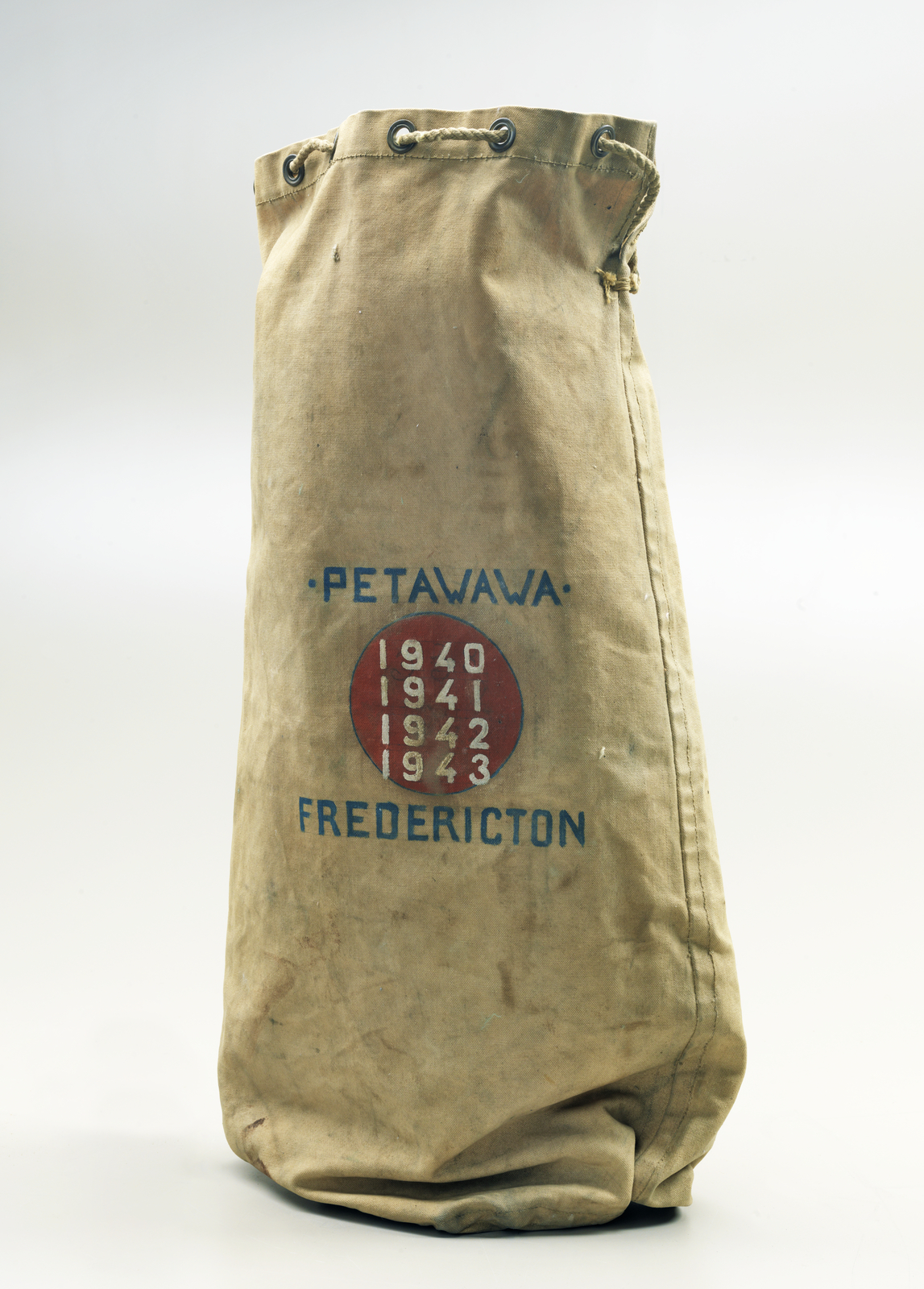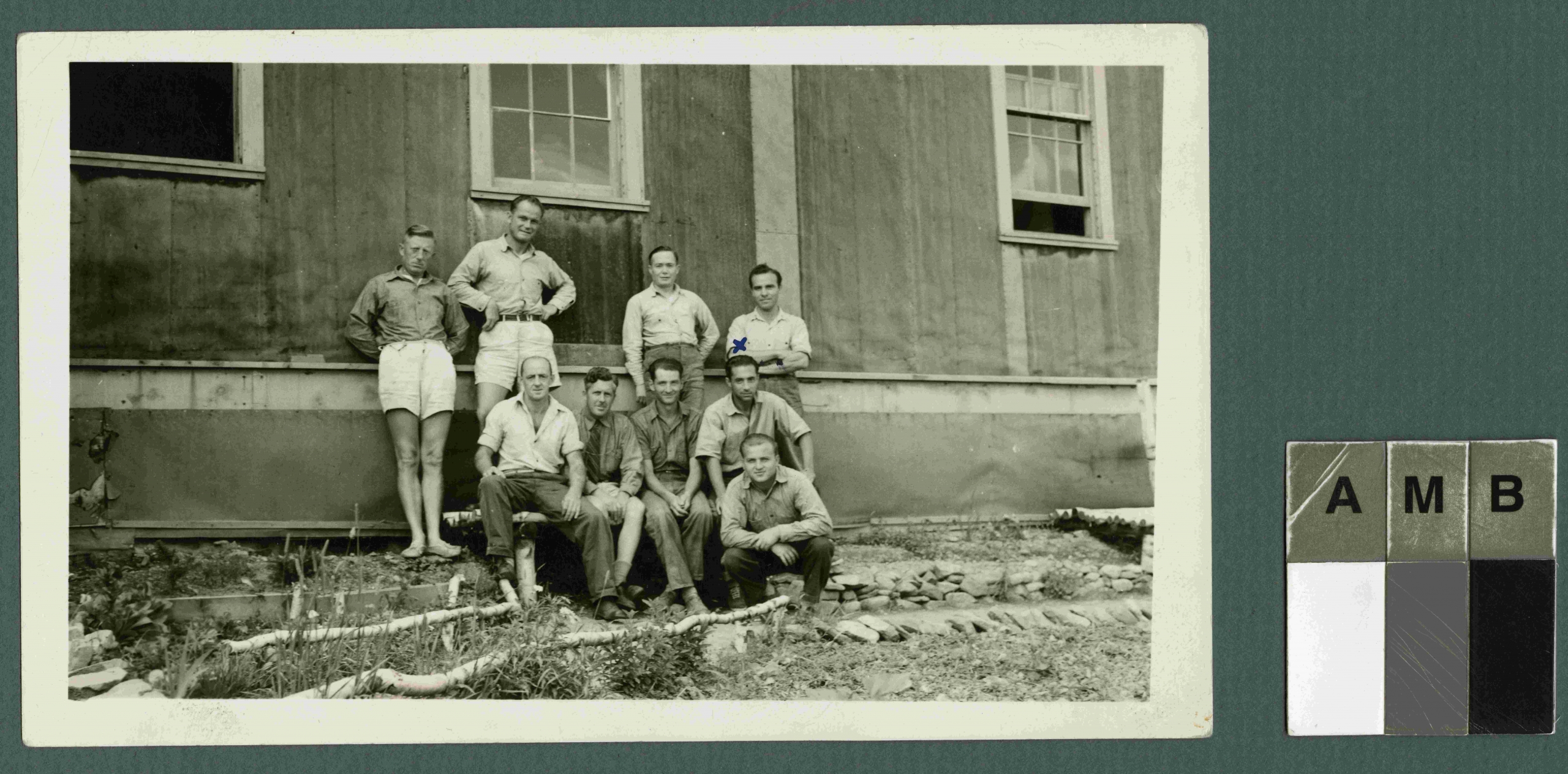Vincenzo Poggi’s Bag
Artifact
Image
Video
Audio
 Activities
Activities
LOOK
Look closely at this bag. What do you think it is? What do you think the places and dates represent? To verify your answer, read the Historical Context below.
THINK
Read the quote from Vincenzo Poggi at the beginning of the In-Depth Historical Context provided. What do you think he’s trying to say? Explain in your own words.
Details
 Materials
Materials - Cotton
Historical Context
Choose one of the three levels below to match your needs.
- When the War Measures Act was invoked at the outbreak of the Second World War, residents from countries at war with Canada — Italy, Japan and Germany — were particularly affected.
- Italian-Canadian artist Vincenzo Poggi was accused of being affiliated with a Fascist propaganda agency, which may have led to his internment.
- Poggi’s bag lists the places and dates of his detentions. The red circle is associated with prisoners of war.
When the War Measures Act was invoked at the outbreak of the Second World War, residents from countries at war with Canada — Italy, Japan and Germany — were particularly affected.
Artist Vincenzo Poggi, who had lived in Canada since 1929, was interned in 1940. His arrest may have been due to his affiliation with a press service that was also a propaganda agency for Fascist Italy.
Poggi’s hand-painted bag lists the places and dates of his detentions, and features the red circle traditionally associated with prisoner-of-war uniforms.
The second slide shows a picture of Poggi.
“I was interned at Petawawa on the 6th January 1942. Fascist leaders within the camp refused to allow me living quarters in hut 11 [because] I was not a good fascist and only good fascists were desired in that particular hut.”
— Vincenzo Poggi, around 1943
When the War Measures Act was invoked at the outbreak of the Second World War, residents from countries at war with Canada — Italy, Japan and Germany — were particularly affected. Artist Vincenzo Poggi, who had lived in Canada since 1929, was interned in 1940. His arrest may have been due to his affiliation with a press service that was also a propaganda agency for Fascist Italy.
Interned in camps in Petawawa, Ontario, and Fredericton, New Brunswick, Poggi was released in 1943 on the condition that he report to the RCMP each month, and avoid any Fascist activity.
Poggi’s hand-painted bag lists the places and dates of his detention, and features the red circle traditionally associated with prisoner-of-war uniforms. Although the bag was provided by the government, Poggi painted it himself.
The second slide shows a picture of Poggi.
- When the War Measures Act was invoked at the outbreak of the Second World War, residents from countries at war with Canada — Italy, Japan and Germany — were particularly affected.
- Italian-Canadian artist Vincenzo Poggi was accused of being affiliated with a Fascist propaganda agency, which may have led to his internment.
- Poggi’s bag lists the places and dates of his detentions. The red circle is associated with prisoners of war.
When the War Measures Act was invoked at the outbreak of the Second World War, residents from countries at war with Canada — Italy, Japan and Germany — were particularly affected.
Artist Vincenzo Poggi, who had lived in Canada since 1929, was interned in 1940. His arrest may have been due to his affiliation with a press service that was also a propaganda agency for Fascist Italy.
Poggi’s hand-painted bag lists the places and dates of his detentions, and features the red circle traditionally associated with prisoner-of-war uniforms.
The second slide shows a picture of Poggi.
“I was interned at Petawawa on the 6th January 1942. Fascist leaders within the camp refused to allow me living quarters in hut 11 [because] I was not a good fascist and only good fascists were desired in that particular hut.”
— Vincenzo Poggi, around 1943
When the War Measures Act was invoked at the outbreak of the Second World War, residents from countries at war with Canada — Italy, Japan and Germany — were particularly affected. Artist Vincenzo Poggi, who had lived in Canada since 1929, was interned in 1940. His arrest may have been due to his affiliation with a press service that was also a propaganda agency for Fascist Italy.
Interned in camps in Petawawa, Ontario, and Fredericton, New Brunswick, Poggi was released in 1943 on the condition that he report to the RCMP each month, and avoid any Fascist activity.
Poggi’s hand-painted bag lists the places and dates of his detention, and features the red circle traditionally associated with prisoner-of-war uniforms. Although the bag was provided by the government, Poggi painted it himself.
The second slide shows a picture of Poggi.
Summary
- When the War Measures Act was invoked at the outbreak of the Second World War, residents from countries at war with Canada — Italy, Japan and Germany — were particularly affected.
- Italian-Canadian artist Vincenzo Poggi was accused of being affiliated with a Fascist propaganda agency, which may have led to his internment.
- Poggi’s bag lists the places and dates of his detentions. The red circle is associated with prisoners of war.
Essential
When the War Measures Act was invoked at the outbreak of the Second World War, residents from countries at war with Canada — Italy, Japan and Germany — were particularly affected.
Artist Vincenzo Poggi, who had lived in Canada since 1929, was interned in 1940. His arrest may have been due to his affiliation with a press service that was also a propaganda agency for Fascist Italy.
Poggi’s hand-painted bag lists the places and dates of his detentions, and features the red circle traditionally associated with prisoner-of-war uniforms.
The second slide shows a picture of Poggi.
In-Depth
“I was interned at Petawawa on the 6th January 1942. Fascist leaders within the camp refused to allow me living quarters in hut 11 [because] I was not a good fascist and only good fascists were desired in that particular hut.”
— Vincenzo Poggi, around 1943
When the War Measures Act was invoked at the outbreak of the Second World War, residents from countries at war with Canada — Italy, Japan and Germany — were particularly affected. Artist Vincenzo Poggi, who had lived in Canada since 1929, was interned in 1940. His arrest may have been due to his affiliation with a press service that was also a propaganda agency for Fascist Italy.
Interned in camps in Petawawa, Ontario, and Fredericton, New Brunswick, Poggi was released in 1943 on the condition that he report to the RCMP each month, and avoid any Fascist activity.
Poggi’s hand-painted bag lists the places and dates of his detention, and features the red circle traditionally associated with prisoner-of-war uniforms. Although the bag was provided by the government, Poggi painted it himself.
The second slide shows a picture of Poggi.


